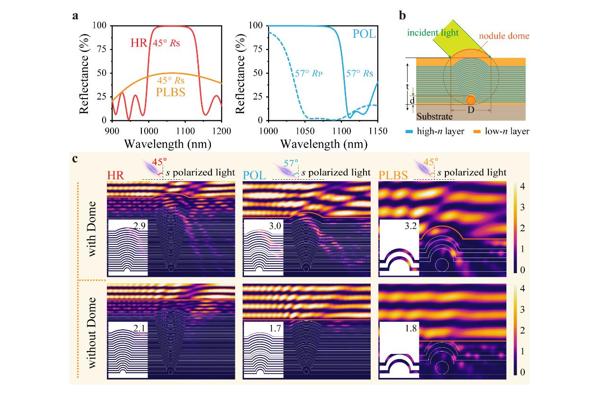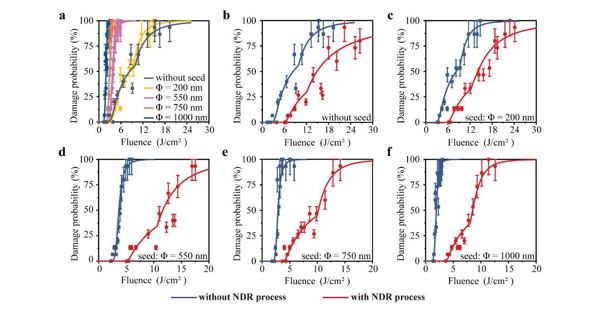Laser damage to mirror coatings caused by nodule defects is one of the bottlenecks limiting further increases in output power of high-power laser facilities. Nodule defects grow from particles on the substrate surface or particles generated during the coating deposition process into inverted cones with domed tops, resulting in unwanted localized electric (E)-field enhancement and coating layer discontinuities. The micro-lens model and angular-dependent transmission model suggest that localized E-field enhancement can lead to nodule ejection under laser irradiation. Due to the diversity of seed sources, nodules are unavoidable in laser coatings. Traditionally, laser conditioning and nodule planarization methods are used to reduce the adverse effects of nodule defects. However, laser conditioning produces plasma scalds and nodule-ejected pits; nodule planarization is limited to ion-beam sputtering deposition, not e-beam evaporation – a technique especially suitable for large, high-power laser optics.
Recently, the Laboratory of Thin Film Optics (Shanghai Institute of Optics and Fine Mechanics) proposed a strategy to remove the nodule dome to reduce the E-field enhancement and thus increase the damage threshold of laser coating. The results were published in High Power Laser Science and Engineering, Vol. 10, Issue 5 (Tianbao Liu, Meiping Zhu, Wenyun Du, Jun Shi, Jian Sun, Yingjie Chai, Jianda Shao. A nodule dome removal strategy to improve the laser-induced damage threshold of coatings [J]. High Power Laser Science and Engineering, 2022, 10(5): 05000e30).

Figure 1. (a) Theoretical reflectance spectra of a mirror coating, a plate laser beam splitter coating, and a polarizer coating. (b) The geometry of the D = sqrt (4dt) nodule. (c) Simulated E-field distributions for the nodules with and without domes (with an incident light with a wavelength of 1064 nm). The inset shows the E-field distribution in high-n layers, and the peak E-field intensity values are given.

Figure 2. Laser-induced damage probability. Single-pulse damage probability as a function of the input fluence for (a) all mirror coatings without the NDR process, mirror coatings deposited on substrates with (b) no artificial nodule defects and artificial nodule defects with seed diameters of (c) 200 nm, (d) 550 nm, (e) 750 nm and (f) 1000 nm.
The paper proposed a nodule dome removal (NDR) strategy to eliminate the unwanted localized E-field enhancement caused by nodule defects, thereby improving the LIDT of laser coatings. First, the reduction of localized E-field enhancement in mirror coatings (HR), polarizer coatings (POL), and plate laser beam splitter coatings (PLBS) by removing nodule domes was theoretically investigated using the finite-element method (Fig.1). For all coatings, the localized E-field enhancement was significantly reduced in nodules without domes compared to nodules with domes, especially in the high refractive index (n) layer, which is more prone to damage under laser irradiation due to its relatively smaller band gap. Then, an UV laser mirror coating with artificial nodule seeds was prepared, and nodule domes were experimentally removed by the NDR process. The LIDT was improved to about 1.9 and 2.2 times for the UV mirror coating without artificial nodules and the UV mirror coating with artificial nodule seeds with a diameter of 1000 nm, respectively (Fig.2).
The NDR strategy enables a higher LIDT of the laser coatings without degrading other properties of the coating such as spectrum, stress, and surface roughness. All these indicate that the proposed NDR process can benefit many areas of laser technology where high-LIDT laser coatings play a key role.


